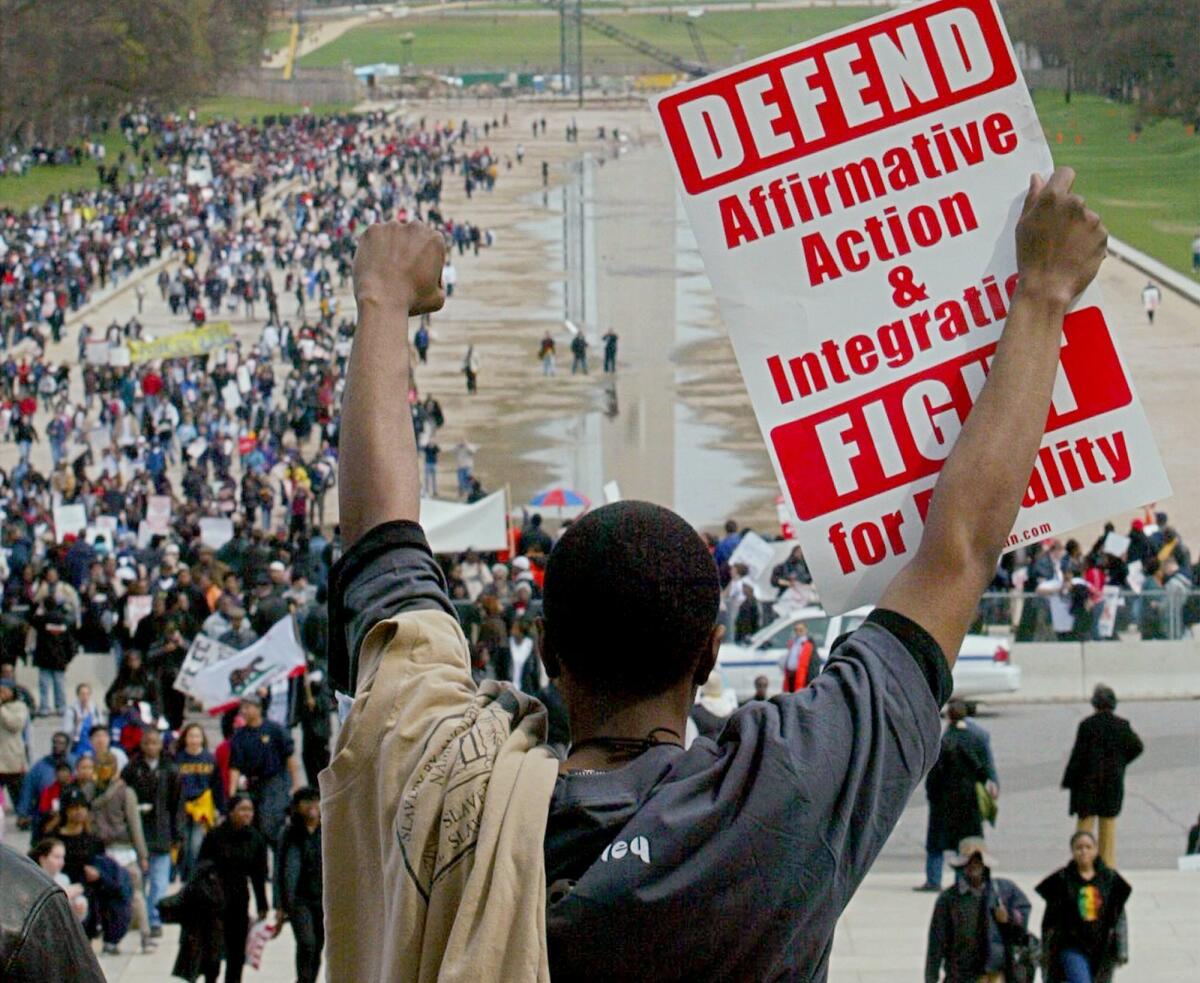From the Archives: U.S. Supreme Court affirms use of race in university admissions

A man stands on the steps of the Lincoln Memorial in Washington, D.C., on April 1, 2003, demonstrating for affirmative action.
- Share via
The Supreme Court, saying the nation has a compelling need for racial and ethnic diversity in its leadership ranks, on Monday endorsed the use of affirmative action at colleges, universities and law schools.
The high court strongly affirmed the principle set 25 years ago in the landmark case of Allan Bakke vs. the University of California. Colleges may consider a minority student’s race as one “plus factor” in weighing an application, as long as they do not use quotas or a fixed-point scale.
Applying that framework in two deeply divided rulings Monday, the court upheld the affirmative action policy at the University of Michigan’s law school because an individual student’s race is weighed as one factor in deciding who is admitted. However, the justices struck down the school’s undergraduate admissions policy because all minority students received bonus points that nearly ensured their admission.
In the most significant of the opinions, Justice Sandra Day O’Connor spoke for five justices in saying that the door to opportunity must be kept open for aspiring black, Latino and Native American students.
“In a society like our own ... race unfortunately still matters,” O’Connor said. “In order to cultivate a set of leaders with a legitimacy in the eyes of the citizenry, it is necessary that the path to leadership be visibly open to talented and qualified individuals of every race and ethnicity.”
Higher education officials and civil rights leaders hailed the outcome as a historic victory, one that preserves integration at the most selective colleges. Until Monday, they had feared a ruling that would entirely close the door to affirmative action in higher education. The principle of affirmative action has also been endorsed by the nation’s military leaders and the heads of some of the country’s best-known corporations.
President Bush also applauded the court “for recognizing the value of diversity on our nation’s campuses. Today’s decisions seek a careful balance between the goal of campus diversity and the fundamental principle of equal treatment under law.”
The decision should have no immediate effect in California. Seven years ago, Proposition 209 outlawed “preferential treatment on the basis of race” at the University of California and other state institutions. Monday’s decision does not change that.
At the same time, private universities such as USC and Stanford may continue to use affirmative action.
The ruling may spell trouble for some large universities. Because of the huge volume of applications, they do not closely evaluate individuals, but instead rely on formulas that consider test scores, grades, and in some instances, the race of the applicants.
The court struck down the University of Michigan’s undergraduate admissions policy because it gave 20 bonus points to “underrepresented” minority applicants, which the university said did not include Asian Americans.
This point system “makes race a decisive factor for virtually every minimally qualified ... minority applicant,” Chief Justice William H. Rehnquist said. The system puts too much emphasis on race and violates the rights of white students to equal protection of the laws, the court concluded.
O’Connor cast the key vote in both of the Michigan cases decided Monday.
In doing so, she followed the path set by her closest friend and mentor on the court, the late Justice Lewis F. Powell.
In the Bakke case, Powell too split the middle between the court’s liberal and conservative factions. He opposed quotas as unconstitutional, but he endorsed the pursuit of diversity by college officials.
Allan Bakke, a white applicant who was rejected by the medical school at UC Davis, was ordered admitted by the high court. However, the Bakke ruling has stood for the principle that college affirmative action is legal.
For the first time in a generation, the Supreme Court revisited the issue when it took up the Michigan cases. And its decision, thanks to O’Connor, affirms the basic result in the Bakke case.
She joined Rehnquist and a conservative majority to reject what she called “the mechanized selection” system used to admit undergraduates.
The final vote in this case was somewhat unclear, since Justice Stephen G. Breyer filed a concurring opinion that agreed both with O’Connor -- who joined Rehnquist -- and with the dissenters. Aligning Breyer with O’Connor would make a 6-3 majority to strike down the undergraduate program.
The law school’s admissions policy was upheld on a straight 5-4 vote. Here, O’Connor spoke for the court and its liberal justices in the far more significant opinion, which permits higher education officials to use “race-conscious admissions” policies.
“Today we endorse Justice Powell’s view that student body diversity is a compelling state interest that can justify the use of race in university admissions,” O’Connor said.
Justice Clarence Thomas quoted abolitionist Frederick Douglass in explaining his dissent.
“If the Negro cannot stand on his own legs, let him fall also. All I ask is, to give him a chance to stand on his own legs,” Douglass told a Boston audience in 1865.
“Like Douglass, I believe blacks can achieve in every avenue of American life without the meddling of university officials,” said Thomas, the only black justice. “Because I wish to see all students succeed, whatever their color, I share, in some respect, the sympathies of those who sponsor the type of discrimination” practiced by the University of Michigan, he said. “The Constitution does not, however, tolerate ... the status quo in admissions policies when [they] ripen into racial discrimination.”
Many legal experts -- friends and foes of affirmative action -- were watching closely to see whether the court would uphold or reject the diversity principle.
By upholding it, the court gives college officials the freedom to use affirmative action, as long as they do not resort to heavy-handed methods.
O’Connor cited briefs filed by leaders of the nation’s military academies and its major corporations as well as its top colleges and law schools, arguing that a strict ban on the use of affirmative action would deprive the armed services, businesses and the legal profession of a thoroughly integrated leadership core.
“We agree ... our country’s most selective institutions must remain both diverse and selective,” O’Connor said.
Colleges may set “minimum goals for minority enrollment,” she said. But all applicants should be considered in a competitive pool. A two-track admissions policy will not do, she said.
The University of Michigan Law School receives about 3,500 applications for 350 seats in its entering class. It chooses from students who have outstanding grades and test scores. It also seeks a “critical mass” of “underrepresented minority” students who are black, Latino or Native American.
In recent years, 13% to 20% of its entering class has been made up of minorities. The proportion would have dropped to about 4% had the law school been required to admit students strictly based on their grades and test scores, O’Connor said.
Barbara Grutter, the white plaintiff, was rejected despite a 3.8 grade-point average and a score of 161 on the Law School Admissions Test. This was better than many of the minority applicants who were admitted, O’Connor noted.
Someday, she said, the nation should revert to a strictly “race-neutral admissions formula” at all colleges. But that time has not arrived, she added.
Requiring a “race-blind admissions policy” now would exclude most of the black and Latino students at the nation’s most selective schools, she said.
Still, affirmative action should not continue forever, she concluded.
“Enshrining a permanent justification of racial preferences would offend [the] fundamental equal protection principle” set by the Constitution, O’Connor said. “We expect that 25 years from now, the use of racial preferences will no longer be necessary to further the interest approved today.”
Justices Breyer, John Paul Stevens, David H. Souter and Ruth Bader Ginsburg joined O’Connor’s opinion in the law school case, Grutter vs. Bollinger. In dissent, Rehnquist called the focus on attaining a “critical mass” of minority students “a naked effort to achieve racial balancing.” Justices Thomas, Antonin Scalia and Anthony M. Kennedy agreed with him.
The court’s upholding of college affirmative action marks a surprising defeat for conservative activists.
Under Rehnquist’s leadership, the high court had in recent years rejected race-based programs that benefited minorities in awarding construction contracts and college scholarships, and in drawing black-majority congressional districts. All the rulings came on 5-4 votes, with O’Connor in the majority.
Lawyers for the Center for Individual Rights relied on these high court decisions to challenge affirmative action policies at universities in Texas and Georgia. They had won in lower courts.
In 1997, they sued on behalf of qualified white applicants who were rejected by the University of Michigan and its law school.
But in the end, they fell short by one vote in the Supreme Court.
“Of course, we are disappointed,” said Curt Levey, a spokesman for the center. “But overall, we feel we moved the ball forward because we have narrowed the permissible use of race.”
Clint Bolick of the libertarian Institute for Justice, another opponent of affirmative action, called the ruling “a tragedy for all Americans.”
For the first time in a long time, civil rights lawyers celebrated a major victory in the Supreme Court.
“By preserving affirmative action, this Court ruling advances the national consensus that colleges and universities should continue to assist in dismantling the present effects of this country’s past system of official apartheid,” said the NAACP Legal Defense Fund in a statement.
“This is a historic day for the achievement of civil rights in America,” added Wade Henderson, director of the Leadership Conference on Civil Rights. “The court rejected arguments that would have turned the clock back on 50 years of civil rights progress.”
In January, the Bush administration urged the Supreme Court to strike down both affirmative action programs at Michigan.
The president praised diversity in principle, but said “Michigan’s policies amount to a quota system.” He said colleges and law schools should be required to use “race-neutral” means to achieve racial diversity.
O’Connor’s opinion rejects that idea, saying it would not work for law schools and other professional schools whose students come from an array of colleges.
More to Read
Sign up for Essential California
The most important California stories and recommendations in your inbox every morning.
You may occasionally receive promotional content from the Los Angeles Times.











